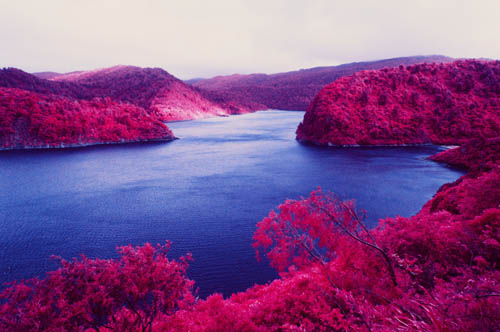Tim Flower on Shooting New Zealand with Camouflage Detection Film
Using camouflage detection film to reinterpret the New Zealand landscape.
We have half an hour before Tim Flower has to get on a plane to Christchurch. After some light probing, he shrugs 'oh it's something for the All Blacks'. Which seems to be quite typical of Tim. Everything he says and does is quite matter of fact. He decided he wanted to become a cinematographer. He became one. He decided he wanted to use camouflage detection film to take landscape photos. So he did. He decided to turn those photos into an exhibition called In a Different Light. So he did, again.
Concrete Playground sat down briefly with the cinematographer behind works such as Romeo and Juliet: A Love Story, Diggin in the Carts with Nick Dwyer Chelsea Jade's 'Visions' and The Checks' 'Candyman Shimmer' to talk about his debut photography exhibition.
Laetitia Laubscher: How did you get the idea behind In a Different Light?
Tim Flower: Well, I've always been interested in light and how we perceive it – I always found that quite interesting. How what we see is our human perception it's not necessarily the reality, it's just our reality. And I discovered a film [Kodak Aerochrome 35mm] that could pick up a different light wavelength and I just found the images incredible.
LL: And why New Zealand landscapes?
TF: Um, a lot of that is to do with what infrared shows up on. So that particular film is used for aerial photography and camouflage detection – so basically anything with chlorophyll – any plants come up pink. Everything else comes up as grey. So it was used to detect where the enemy spaces were.
LL: You also said in your gallery excerpt that it was because people are quite used to seeing NZ in a certain way.
TF: Yeah, exactly. We definitely have a certain, specific idea of what 'beautiful New Zealand' is.
LL: How did this exhibition come about?
TF: Photography's always been a hobbie on the side, and this started out when I found a roll of film on Ebay and thought I'd go try it out and then I ended up buying more and more and more, some friends saw the photos and wanted to buy some, someone suggested I should have an exhibition and yeah, now we're here.
LL: When did your love of cameras start?
TF: I was actually first into photography, and then I got into cinematography. My dad and my uncle were really into photography. I worked at a vintage camera store – Jacobs Photo and Digital – when I was 17/18 so I was around cameras a lot, learnt a lot about them, played around with film and stuff. Now it's a little different, but back then it was packed floor-to-ceiling with cameras.
LL: Who are your heroes of cinematography?
TF: Emmanuel Lubezki, Roger Deakins and Adam Arkapaw. They're probably my favourites.
LL: What's your philosophy on cinematography?
TF: Cinematography is primarily telling the story as well as you can, and then making it look nice as well. Essentially what's important is a good script, you can shoot something on a pretty average camera but it can be good because of the story you're telling.
LL: What does it take to be a successful cinematographer?
TF: I guess it's just building up a base of contacts. I did a bit of everything, I worked as a camera assistant, I shot music videos, I did a bit of other documentary camera work on the side, I did some editing as well...
LL: What was your first shoot?
TF: I think one of the first shoots we did was one of the ones I made, with Tim van Dammen, was the one for Sola Rosa. Yeah, it was one of our first videos and we ended up getting nominated for a Vodafone Music Award. It was a good start.
LL: How did you meet Tim?
TF: We became mates because I lived in the apartments in St Kevins and Tim ended up moving in there and we became friends through that.
LL: Did you go to any film school?
TF: No. Just self-taught. I totally think that the information and the resources are totally out there now – if you want be a cinematographer you can do it.
LL: Any key books that taught you a lot?
TF: Not really. I just did a lot of research. When I knew that's what I wanted to do I just read everything I could about cinematography. I just took every opportunity I could to learn new things and to play with gear and shoot whatever I could.
LL: Movies?
TF: There was definitely a series of films that got me into cinematography, the late '90s, early 2000s visual films like Requiem for a Dream, City of God, Amelie. Those really visual films.
Tim Flower's exhibition In a Different Light will be showing at Depot Artspace from July 18 until August 5.







